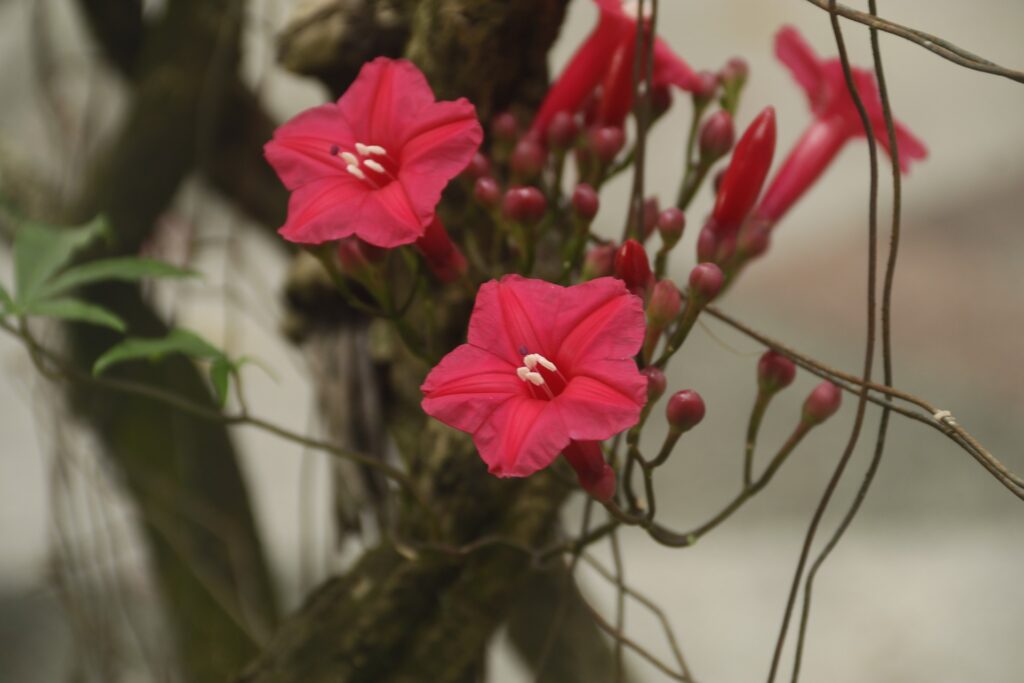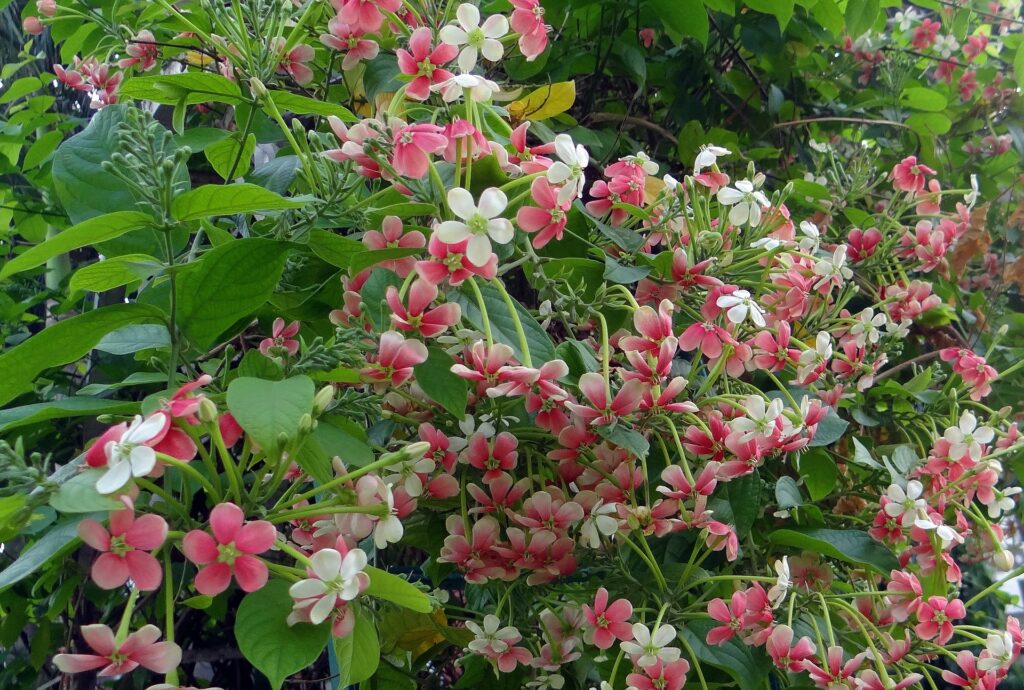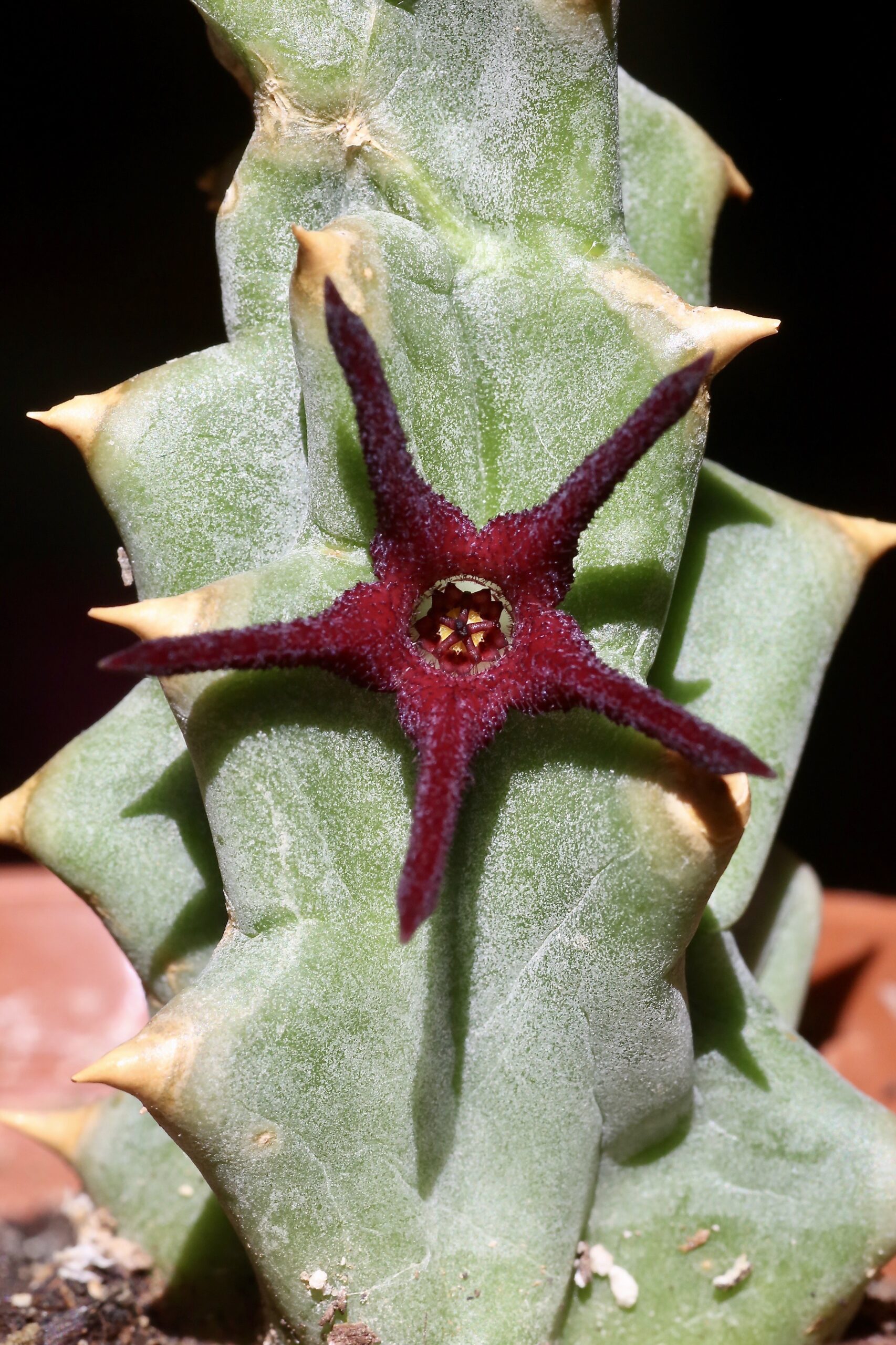In terms of flowers that start with Q there are potentially 6, and there are only four that actually produce a flower. It’s one of the least used letters at the start of a plant name, alongside Y and X.
In terms of a plant encyclopedia this is the page that will get overlooked the most, but there are still some interesting ones to look at. Moreover, the less plants to remember the more likely you are to retain the information – silver linings and all that. Read on to see what we found!
1. Quamoclit (AKA Ipomoea)
Ipomoea is a large genus of flowering plant from the family Convolvulaceae, there are over 600 species of Ipomoea that vary widely. As a result of such a large genus, there are many other names for Ipomoea some you may recognise such as ‘morning glory’ or ‘moonflower’, as well as Quomoclit.
RELATED: 9 Interesting Flowers That Start With I (With Pictures)

Funnily enough, for the amount of species with this genus, many of them actually fight for spice. The widely varied species of Ipomoea can fight for and interfere with each other’s pollination and compete within the reproductive process – for the evolutionary biologists among us this causes the phenomenon known as ‘fitness’ whereby evolution is affected by this fight for pollen.
The wide range within the genus can consist of annual and perennial herbaceous plants as well as shrubs, small trees, and climbing plants. Regardless of species, the Ipomoea plant produces an elegant flower that is widely cultivated for its ornamental and decorative qualities.
Variety of Colors:
Across the wide range of species color can vary widely even having a black variety. Many cultivars have been made in order to create unique colors. These flowers often bloom at night hence the common name ‘moonflower’.
What may seriously surprise you, is that among the 600+ species are food crops such as the sweet potato (I. batatas) as well as ‘water spinach’ (I. aquatica) which have been important food items throughout time. Although even the sweet potato plant has an impressive and showy flower that people love to grow for its ornamental prowess.
Even more impressively, this genus also has medicinal and entheogenic qualities within certain species. Certain species of Ipomoea are used to create ‘jalap’ – a largely obsolete medicine in the west, but is used among hermetic practitioners to help with constipation.
Other uses:
Moreover, the Ipomoea genus has many psychedelic or entheogenic uses. In the Aztec and Zapotec era, the Ipomoea tricolor was used both as a shamanic psychedelic as well as a poison to induce ‘bad trips’ for the enemy with high doses.
It’s likely that Ergoline is the cause of the plant’s psychedelic properties, or a derivative known as lysergamide, both aren’t far away from LSD (Lysergic acid diethylamide). Although there is a lot of scientific debate about the plant mechanisms that lead to the production of psychedelic effects. While Ergoline is psychoactive it isn’t hallucogenic, similar to marijuana.
Alexander Sschulgin, a prominent chemist and psychonaut, suggests its ergonovine which is the culprit. Many suggest that Ipomoea has many medicinal benefits that we should research more, but certain laws and regulations prevent the cultivation of Ipomoea for anything more than ornamental purposes.
2. Quesnelia
The Quesnelia is a genus of flowering plants that are generally endemic to tropical regions such as their family, Bromeliaceae, which includes the Pineapple. The Quesnelia is specifically endemic to eastern Brazil’s tropical biome. There are two subgenus within Quesnelia.

The genus was named after French patron Edouard Quesnel who contributed remarkable funds to the study of botany. As wel as being a consul within French Guiana.
There are 22 recognised species within the genus, many of which can differ especially in terms of inflorescence. Many are present in the ‘Atlantic Forest’ ecoregion in Southern Brazil. However, flowers can differ. Some flower heads contain multiple flowers within them that form one larger inflorescence, while others have single flowers on panicles instead.
The plant can grow 2 to 3 feet tall with an equal spread. It might interest you to know, in terms of general botany, that there are 350,000 known plant species, roughly, and around 50,000 of these plants are endemic to Brazil and its widely varied ecology.
Tolerance:
Most Quesnelias are very drought tolerant and actually survive the cold well. The less sun absorbed by the plant will result in the long sabre-like leaves becoming long and green. Although, with more sun the leaves are compact and red.
Their hardiness and showy, bright flower makes them popular among landscapers of subtropical climates especially as they require such low maintenance. Moreover, the plant is very unfussy especially with soil, it can grow in almost any soil like a rose can. The main requirement when growing this plant is sunlight, it’s worth understanding the climate this plant grows within in order to get the most out of your plant.
3. Quisqualis (AKA Combretum)
The Quisqualis is a genus of flowering tropical plant that has undergone some reclassification and renaming and is now known in modern botany as Combretum, from the family Combretaceae. Within this genus there are a whopping 272 recognised species, most of which are endemic to tropical Africa and some to other tropical settings in America, Madagascar, Asia, etc.

The species are composed of trees and shrubs some of which have interesting inflorescence. Species of Combretum have been found as recently as 2020. Much historical discovery of this genus is down to Scottish botanist George Don.
While not a close relative, these Combretum often appear in the same habitats as the willow tree. The tree species are often very important within their habitat. Savannas in Africa are often full of these trees as well as its close relatives who enjoy granitic soils.
Genus:
The Combretum genus is very common within the Angolan mopane woodlands ecoregion as well as the Southwestern Amazonian moist forests. Within these forests the Combretum are interestingly pollinated by mammals which is quite rare for a plant, most are pollinated by insects and occasionally birds.
Many of these species make their way into African and Indian herbal medicinal practices. THere are a class of chemical compounds combretastatins were first found in the Combretum caffrum. Derivatives of this compound were used in thyroid cancer trials.
Other species also contain strong antioxidants such as punicalagin also present in the closer relative the pomegranate. Some say combretums fruit can cure hiccups.
Flowering takes place in the September and October months, and potentially even later. The flowers are a clustered inflorescence that creates a striking flower. THe stamens are particularly interesting. They also produce fruit that has an edible nut inside.
4. Quaqua
The genus Quaqau is of the Apocynaceae family, and specifically a tribe of plants known collectively as stapeliads – all of which are stem succulents. The genus is endemic to Africa and specifically the ecoregion of Namaqualand where the plant is rife. Generally the plant only really occurs on the western side of South Africa and Namibia as this is the side that gets rain especially during winter.

Within this genus the species vary widely and are generally divided into two groups based on their inflorescence. The species that bear flowers singularly or in pairs are considered to be their own category. While the plants that bear flowers up to 20 are grouped separately for this reason.
Subgroups:
Again, this latter category of species can be subdivided into another two categories depending on inflorescence. The flowers of this second group that are purple or brown and are wider than an inch are considered a sub group. While the other flowers that are narrow and lighter in color are considered another sub group.
The stem of this succulent is usually identifiable as it has 4 or 5 firm stems that have conical tubercles which have a spike at the end. Although not all species have spikes. Compared to other stapeliads, the Quaqua’s flowers differ greatly.
Generally, the Quaqua can have multiple flowers arranged along the stem vertically. Strangely, the Quaqua’s species’ flowers differ greatly by species. Most notably, certain species have flowers that have a generally repulsive smell like a sewer or of excrement. While other species have very sweet and enjoyable scents.
The species that smell the best are generally the ones that are cultivated. While the stinky ones usually emerge in the wild.
Our Final Say
So there you go, four plants that begin with Q that I bet you didn’t already know. This goes to show that no matter the name of the plant or the letter it starts with there can be many interesting plants yet to explore.
A lot of the reason for Q being such an underused letter is purely a coincidental by-product of the reclassification that has been happening in the 21st century thanks to modern uses of molecular technology.
The only flowering plants that begin with Q which are recognised within modern botany is actually the Quesnelia. And even then this plant is named after someone which is why it has the Q. And the succulent Quaqua which is the only other. Other names have been changed due to reclassification.
We hope you learned something from this article, here are other articles that you can learn from:
16 Beautiful Blush Flowers (Including Photos)







